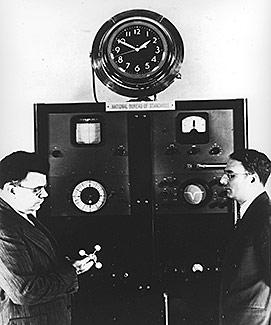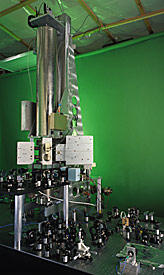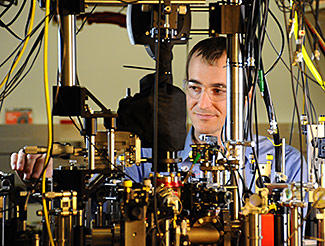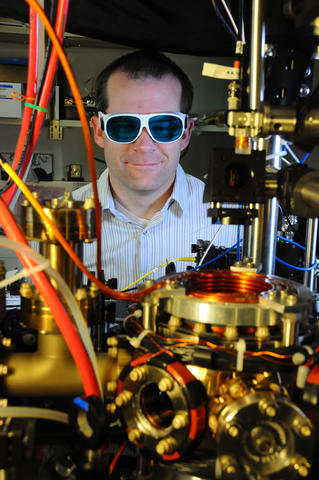
A revolution is under way in timekeeping. Precision timekeeping based on atomic clocks already underpins much of our modern technology—telecommunications, computer networks and satellite-based positioning systems like GPS that are used by billions of people every day. But now research at NIST, JILA* and other organizations throughout the world is improving atomic clock performance so quickly that many new applications are expected in the near future. At both NIST and JILA, NIST scientists are leading research on new atomic clocks in collaboration with students, postdoctoral fellows and scientists from across the world.
Atomic clocks keep time based on the natural oscillations (or frequencies) of atoms, which are much more stable and accurate than any mechanical devices. The atomic clock was invented at NIST in 1949 (then the National Bureau of Standards), and atomic clocks quickly became more accurate than any other timekeeping technologies.
Atomic clocks began to have notable impacts on other technologies about 20 years later. Atomic time standards have been in use since 1967, when one of the cesium atom's natural frequencies was selected by an international committee as the basis for the international unit of time, the "SI second". The second is defined as exactly 9,192,631,770 oscillations or cycles of this cesium atom resonant frequency. NIST operates two U.S. civilian time and frequency standards based on cesium: NIST-F1 keeps time to within 1 second in about 100 million years as of 2013, and NIST-F2, introduced in early 2014, is about three times better at plus or minus 1 second in about 300 million years.
Meanwhile, NIST scientists have been developing next-generation atomic clocks based on a variety of different atoms, including mercury, aluminum, ytterbium, strontium and calcium. These experimental clocks have been improving rapidly, and each offers different advantages. These clocks may enable new technologies, and one or more of them might become future time standards.
Beyond Timekeeping
Improved atomic clocks obviously will benefit widely used technologies that have long relied on precision timekeeping, such as communications and GPS positioning. But the new atomic clocks are becoming so extraordinarily precise that they are likely also to be used as extremely sensitive detectors for many things besides time.
For example, the frequency ("ticking rate") of atomic clocks is altered slightly by gravity, magnetic fields, electrical fields, force, motion, temperature and other phenomena. In today's conventional atomic clocks, those frequency changes are errors to be tightly controlled. In next-generation atomic clocks, the frequency changes are measured to such a fine degree that the clocks could become world-class instruments for measuring gravity, magnetic and electrical fields, force, motion, temperature and many other quantities.
Today's precision timekeeping technologies rely on several different types of atomic clocks, but in the future, an even wider range of clocks might be used, each optimized for different applications. NIST invests in a number of atomic clock technologies because the results of scientific research are unpredictable, and because different clocks are suited for different applications.
The unpredictability of research outcomes can be seen in recent history. Several years ago, an experimental NIST clock based on a single ion (electrically charged atom) of mercury was the world record holder for precision (see definitions below). Then a NIST clock based on a single aluminum ion and quantum computing technologies surged ahead. Now NIST clocks based on cold neutral atoms in optical lattices have taken the lead after lagging substantially behind for many years. All these clocks are likely to continue improving, and leadership in performance may continue to shift back and forth in the future. Meanwhile, the research has already produced spinoff innovations, such as the world's most stable lasers, and more such discoveries can be expected. Additional new types of atomic clocks not yet envisioned might also be developed.
The suitability of various clocks for different applications can also be seen in recent history. For example, the aluminum ion logic clock's world-record timekeeping performance was due in part to this clock's insensitivity to changes in magnetic fields, electrical fields, and temperature. This insensitivity is highly desirable for the best timekeeping results. But it also means the aluminum ion clock is not a good candidate for measuring magnetic and electrical fields or temperature, whereas other NIST atomic clocks have greater sensitivity to those quantities.
NIST's Atomic Clocks
All clocks must have a regular, constant or repetitive process or action to mark off equal increments of time. Examples include the daily movement of the sun across the sky, a swinging pendulum or vibrating crystal. In the case of atomic clocks, the beat is kept by a transition between two energy levels in an atom.

NIST-F1 and NIST-F2 are microwave clocks, based on a particular vibration in cesium atoms of about 9 billion cycles per second. Optical atomic clocks are based on ions or atoms vibrating at optical frequencies (visible, ultraviolet or infrared light), which are about 100,000 times higher than microwave frequencies. Because optical clocks divide time into smaller units—like a ruler with finer tick marks—they ultimately could be perhaps 100 times more accurate and stable than microwave clocks. Higher frequency is one of the features enabling improved accuracy and stability. One key advance making optical atomic clocks possible was the development of frequency combs at JILA, NIST and elsewhere. Frequency combs link optical frequencies to lower frequencies that can be correlated with microwave standards and counted.
NIST's first all-optical atomic clock, and the best in the world for several years, was based on a single mercury ion. Its performance was then surpassed by NIST's quantum logic clock, based on a single aluminum ion. This clock got its nickname because it borrows techniques from experimental quantum computing. Aluminum is insensitive to changes in magnetic and electric fields and temperature, making it a great ion for atomic clocks, but it wasn't practical until NIST developed new quantum computing technologies.
NIST and JILA are leaders in the development of so-called optical lattice clocks. These clocks trap thousands of heavy metal atoms in an "optical lattice" formed by intersecting laser beams. Research clocks at NIST use ytterbium atoms and JILA research clocks use strontium atoms. Thanks to the presence of so many atoms, these clocks offer the advantages of strong signals and parallel processing. In addition, the atoms are held virtually still in the lattice, reducing errors from atomic motion and collisions that otherwise would need to be corrected.
Optical lattice clocks are rapidly improving, and continue to set new performance records so often that it is difficult to keep track of the latest records. Both the JILA strontium and NIST ytterbium optical lattice clocks are rapidly advancing in stability. And now, for the first time in decades, a single type of atomic clock, an optical lattice clock, simultaneously holds the records for both precision and stability – and it is likely optical lattice clock performance will continue to significantly improve.
This rapid improvement in optical lattice clocks at JILA and NIST results from key scientific breakthroughs. One has been the development of extremely stable lasers, including the world's most stable laser at JILA. Another key breakthrough has been development of new theories about how atoms trapped in the optical lattices interact, and application of these theories to significantly reduce the uncertainties in optical lattice clocks. And much of the improvement results from the hard and creative work of many scientists, students and postdoctoral fellows to continually find new ways to make a series of many small improvements in clock performance.
NIST also has demonstrated a calcium atomic clock that is extremely stable for short time periods. This clock has the potential to be made portable, making it attractive for commercial applications.

Evaluating Atomic Clock Performance
Accuracy refers to a clock's capability to measure the accepted value of the frequency at which the clock atoms vibrate, or resonate. Accuracy is crucial for time measurements that must be traced to primary standards such as NIST-F1 and NIST-F2. Technical terms for accuracy include "systematic uncertainty" or "fractional frequency uncertainty"—that is, how well scientists can define shifts from the true frequency of an atom with confidence.
Cesium standards like NIST-F1 and NIST-F2 are the ultimate "rulers" for time because the definition of the SI second is based on the cesium atom. More specifically, the SI unit of frequency, the Hertz, is defined internationally by the oscillations of a cesium atom. Officially, no atomic clock can be more accurate than the best cesium clock by definition. That is, only a direct measurement of the particular cesium transition can be considered the ultimate measurement of accuracy, and all other (non-cesium) clocks can only be compared to the accuracy of a cesium clock. This is partly a semantic issue. If after further development and testing the definition of the second (or Hertz) were changed to be based on the strontium atom transition, for example, the NIST/JILA strontium atom lattice clock would become the most accurate clock in the world.
To get around this measurement hurdle, NIST scientists evaluate optical atomic clocks by comparing them to each other (to obtain a ratio, or relative frequency, for which there is no official unit), and by measuring all deviations from the true resonant frequency of the atom involved, carefully accounting for all possible perturbations such as magnetic fields in the environment. The optical clock performance is also directly compared to the NIST-F1 standard. For several years both NIST ion clocks have had measured relative uncertainties much smaller than NIST-F1's.
(In general literature, NIST sometimes uses the term "precise" to describe the performance of optical clocks, because it less technical and has a more positive connotation than uncertainty. Precision implies that repeated measurements fall within a particular error spread around a given value. In everyday definitions of precision, this value is not necessarily the "correct" one—you can be precise without necessarily being accurate. However, in the context of optical clocks, NIST uses precision specifically to mean the spread around the true or accepted value for the atom's resonant frequency.)
Stability is another important metric for evaluating atomic clocks. NIST defines stability as how precisely the duration of each clock tick matches every other tick. Because the ticks of any atomic clock must be averaged for some period to provide the best results, a key benefit of high stability is that optimal results can be achieved very quickly. Stability is not traceable to a time standard, but in many applications stability is more important than absolute accuracy. For example, most communications and GPS positioning applications depend on synchronization of different clocks, requiring stability but not necessarily the greatest accuracy. (Other common terms for stability include precision.)
The optical lattice clocks at NIST and JILA are much more stable than NIST-F1. NIST-F1 must be averaged for about 400,000 seconds (about five days) to achieve its best performance of about 1 second in 100 million years. In contrast, the ytterbium and strontium lattice clocks reach that level of performance in a few seconds of averaging, and after a few hours of averaging are about 100 times more stable than NIST-F1.
NIST scientists are also working to improve the portability of next-generation atomic clocks for applications outside the laboratory.
Applications for Better Atomic Clocks
History has shown that better clocks always find practical uses, often unpredictable ones.
Past advances in atomic clock performance enabled the development of technologies such as GPS positioning and navigation and made them commonplace – nearly everyone carrying a cell phone or smart phone is using GPS. NIST atomic clocks are used for many purposes, including guidance of deep space probes. The Financial Industry Regulatory Authority requires that all electronic transactions be stamped with a time traceable to NIST. NIST's Internet Time Service, which allows the public and other users to synchronize their computers' internal clocks with NIST time, received more than 12 billion hits per day as of 2013.
The record performance of optical atomic clocks has already contributed to scientific research. NIST clocks have provided record measurements of possible changes in the "fundamental constants" of nature, a line of inquiry that has huge implications for cosmology, and tested Einstein's theories of relativity.
NIST scientists also envision many practical applications. Optical atomic clocks also might be used to make new types of sensors measuring quantities that have tiny effects on ticking rates, including gravity, magnetic fields, force, motion and temperature. An example is precision geodesy, or mapping of gravity fields near the surface of the earth. A change in height of 10 centimeters (about four inches) near the Earth's surface corresponds to a change in atomic clock frequency (ticking rate) of about 1 x 10-17—the equivalent of about one second in 4 billion years. NIST experimental atomic clocks already exceed this performance level in the lab. If this performance can be realized in the field, precision measurements of gravity could be useful in geology or hydrology.
Use of optical atomic clocks for fast, precision measurements of magnetic and electrical fields, force, motion, temperature and other quantities could lead to technologies for new applications in advanced manufacturing, medical imaging and diagnosis, and many other areas.
Selection of a Future Time Standard
Time standards such as the SI second are chosen by consensus of the world scientific community and, more formally, by the General Conference for Weights and Measures. When cesium was selected as the international time standard in 1967, NIST and other national standards laboratories already had many years of experience with cesium clocks, leading to wide acceptance of the technology.

As many new types of optical atomic clocks are developed at NIST, JILA and across the world, and as these clocks continue to improve at an accelerating pace, the international scientific community may or may not re-define the SI second based on one new type of atomic clock. Instead, the scientific community has been discussing the possibility of selecting several different coordinated standards for the SI second. That approach would avoid some of the problems that stem from having one single standard (currently cesium) that is the sole source of "accuracy." NIST and timing laboratories throughout the world continue to discuss what might be the most practical and meaningful approaches for the future. (Some optical clocks are already recognized as "secondary representations of the SI second.")
Many experimental optical atomic clocks are operating around the world. The existence of many clocks of the same type provides ample opportunities for comparisons and a basis for future redefinitions of the SI second. About a dozen strontium lattice clocks and six ytterbium lattice clocks are operating in national metrology institutes and universities, with several more in the planning stages. There are also several different types of single-ion atomic clocks operating around the world. Currently only NIST operates single ion clocks based on mercury and aluminum, although aluminum ion clocks are under development in other laboratories.
As noted above, both accuracy and stability are important in timekeeping and atomic clock applications. For decades, the most accurate atomic clocks (cesium-based clocks) were not the most stable. That led to the current practice of using cesium clocks such as NIST-F1 to periodically calibrate collections of more stable atomic clocks such as hydrogen masers for practical applications. High performance optical lattice clocks are now simultaneously the most precise (or accurate in the terminology used for standards) and most stable clocks in the world. If the SI second were redefined to include ytterbium and strontium as standards, this coincidence of accuracy and stability could lead to many practical changes in atomic clock applications and the international system of timekeeping. In any case, it is likely that in the future even more types of atomic clocks will be in regular use for the ever-growing range of applications.
*JILA is the joint research and training institute of NIST and the University of Colorado Boulder.

